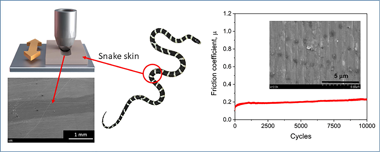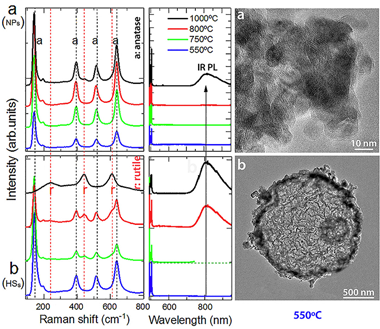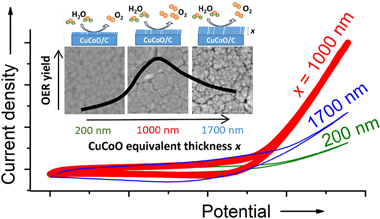Scientific Papers in SCI
2021
2021
Tribología y Protección de Superficies
Long-term low friction maintenance and wear reduction on the ventral scales in snakes
Sanchez-Lopez, JC; Schaber, CF; Gorb, SNMaterials Letters, 285 (2021) 129011
Show abstract ▽

Snake skins evolved to withstand permanent friction and wear during sliding. Here, the microstructure of ventral scales of the snake Lampropeltis getula californiae was analyzed using scanning electron microscopy, and the long-term dynamic friction behavior was investigated by reciprocating sliding friction tests. A smooth epoxy resin with similar elasticity modulus and hardness was used for comparison purposes. Strong differences in frictional and wear mechanisms between the two materials were revealed in spite of similar mechanical properties. Snake skin showed a considerably lower frictional coefficient that kept stable over several thousands of sliding cycles. A reduction of the stick-slip behavior was also denoted by analyzing the variation of the friction coefficient in the forward and reverse motion influencing the wear mechanism. This frictional behavior can be explained by three different but complementary mechanisms: fibrous layered composite material of the skin with a gradient of material properties, surface microstructure, and the presence of ordered layers of lipid molecules at the skin surface.
February, 2021 | DOI: 10.1016/j.matlet.2020.129011
Materiales Ópticos Multifuncionales
Impact of Tb4+ and morphology on the thermal evolution of Tb-doped TiO2 nanostructured hollow spheres and nanoparticles
Colomer, MT; Rodriguez, E; Moran-Pedroso, M; Vattier, F; de Andres, AJournal of Alloys and Compounds, 853 (2021) 156973
Show abstract ▽

Tb-doped TiO2 hollow spheres (HSs) in the range 0.0-2.0 at.% have been synthesized by the first time to the best of our knowledge. The HSs are compared with nanoparticles (NPs) to evaluate the impact of morphology on their physicochemical and photoluminescence (PL) behavior upon increasing calcination temperature. After calcination at 550 degrees C, the particles are anatase with a primary average size of 10.0 +/- 0.2 nm for the NPs and 12.0 +/- 0.2 nm for those that form the micron sized hollow spheres of 1.8 +/- 0.2 mu m diameter and ca. 64 nm shell thickness. The temperature of the anataseerutile transition is found to be strongly dependent on the presence of Tb as well as on morphology. Contrarily to the usual stabilization of anatase when doping with trivalent rare-earth ions, the transition temperature is reduced when doping with Tb. The rutile phase is further favored for the HSs compared to the NPs probably related to the low density of the HSs and/or a more efficient packing density and/or a bigger crystal size of the nanoparticles that form those spheres with respect to the packing and the size of the NPs and/or the crystal size of the nanoparticles of the HSs with respect to the size of the NPs. Only a slight unit-cell volume increase for the anatase structure is observed upon Tb doping, in both the NPs and in the HSs, contrary to the expected increment due to the larger ionic radius of Tb3+ compared to Ti4+. In addition, the intensity of the characteristic f-f Tb3+ emission bands is extremely weak both in the anatase and rutile phases. The transition is accompanied with the emergence of an infrared emission band centered at 810 nm related to the formation of defects during the structural transformation providing deep levels in the gap that partly quench the f-f emissions in the rutile phase. The results are consistent with the presence of Tb in both +3 and +4 valence states. XPS measurements confirmed the presence of Tb3+ as well as of Tb4+ in both HSs and NPs. The large fraction of Tb4+ present in the samples originates the weak f-f emission intensity, an only slight increase of the cell parameters and the destabilization of the anatase phase.
February, 2021 | DOI: 10.1016/j.jallcom.2020.156973
Tribología y Protección de Superficies
Insights into the role of the layer architecture of Cr-Ti-N based coatings in long-term high temperature oxidation experiments in steam atmosphere
Mato, S; Sanchez-Lopez, JC; Barriga, J; Perez, FJ; Alcala, GCeramics International, 47 (2021) 4257-4266
Show abstract ▽
Knowledge on hard coatings has been applied in the energy field extending their use as protecting coatings of steam power generation plants components. The role of the layer architecture of Cr-Ti-N based coatings deposited by reactive cathodic arc evaporation on P92 steel substrates was studied with the focus on their oxidation resistance at 650 degrees C in 100% steam atmosphere up to 2000 h. Characterization of the coatings was performed by gravimetry, scanning electron microscopy, electron probe microanalysis, glow discharge optical emission spectroscopy, X-ray diffraction, thermodynamic simulations using the CALPHAD method, Rockwell C indentation and nanoindentation. The layered arrangement improves the oxidation resistance of TiN under the working conditions of steam power plants, as well as the mechanical properties of CrN. The produced architectures performance under the described working conditions boosts the understanding of the processes taking place at high temperature, making possible the design of optimal coatings combining the best behavior of both nitrides for each specific application, reaching a corrosion protection at high temperature in water vapor comparable to that of CrN and a hardness and Young's modulus as high as those of TiN.
February, 2021 | DOI: 10.1016/j.ceramint.2020.10.003
Nanotecnología en Superficies y Plasma
Active sites and optimization of mixed copper-cobalt oxide anodes for anion exchange membrane water electrolysis
Lopez-Fernandez, E; Gil-Rostra, J; Escudero, C; Villar-Garcia, IJ; Yubero, F; Consuegra, AD; Gonzalez-Elipe, ARJournal of Power Sources, 485 (2021) 229217
Show abstract ▽

The optimization of the catalysts incorporated to the electrodes for anion exchange membrane water electmlysers is a key issue to maximize their performance through the improvement of the oxygen evolution reaction (OER) yield. In this work, we show that the modification of the microstructure and the chemical properties of a mixed copper-cobalt oxide anode may contribute to increase the activity of this reaction. For this purpose, the OER has been systematically studied, either in a half cell or in a membrane electrode assembly configuration, as a function of the load and agglomeration degree of the catalysts used as electrodes, as prepared on a carbon paper support by magnetron sputtering deposition in an oblique angle configuration. Chemical analysis by X-ray absorption spectroscopy and electrochemical analysis by cyclic voltammetry and impedance spectroscopy have shown that cobalt-copper mixed oxide catalysts with a 1.8 Co/Cu atomic ratio and about one micron equivalent thickness maximizes the cell performance. The chemical, structural and microstructural factors controlling the final behaviour of these anodes and accounting for this maximization of the reaction yield are discussed on the basis of these characterization results and as a function of preparation variables of the electrodes and operating conditions of the cell.
February, 2021 | DOI: 10.1016/j.jpowsour.2020.229217
Propiedades mecánicas, modelización y caracterización de cerámicos avanzados
The Possible Detriment of Oxygen in Creep of Alumina and Zirconia Ceramic Composites Reinforced with Graphene
Cano-Crespo, R; Rivero-Antunez, P; Gomez-Garcia, D; Moreno, R; Dominguez-Rodriguez, AMaterials, 14 (2021) 984
Show abstract ▽
This paper aims to give an answer to the following question: is the oxidation of graphene a critical issue for high-temperature plasticity in graphene-reinforced ceramics? To give a convincing reply, we will focus on two very different graphene-based ceramic composites: reduced graphene oxide (rGO)-reinforced alumina (alpha-Al2O3) and reduced graphene oxide (rGO)-reinforced yttria tetragonal zirconia (t-ZrO2). The processing of the powders has been made using a colloidal route, and after that, a spark plasma sintering process was performed in order to densify the samples. Creep tests were performed at temperatures between 1200-1250 degrees C in an argon atmosphere. The microstructure obtained by SEM of the sintered and tested specimens was characterized quantitatively to elucidate the deformation mechanism. Raman spectroscopy was carried out to check the integrity of the graphene. The average grain size was in the order of 1 mu m and the shape factor was 0.7 for all the studied materials. The integrity of the graphene was checked before and after the creep experiments. The careful analysis of the creep tests shows that graphene oxide or its reduced version are not efficient phases for creep resistance improvement in general, contrary to what is reported elsewhere. However, the results permit the suggestion of a creep improvement in nanocomposites at a very high temperature regime due to an enhanced reactivity of oxygen between carbon and alumina interfaces. In the case of zirconia, the results give us the conclusion that the oxidation of graphene is a highly detrimental issue regarding the improvement of high-temperature plasticity.
February, 2021 | DOI: 10.3390/ma14040984
- ‹ previous
- 85 of 410
- next ›














